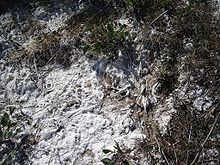Solontchak
Solontschak ( Russian Солончак , wiss. Transliteration Solončak ) is the Russian name for salt soil. The Solontschak is a reference soil group of the World Reference Base for Soil Resources (WRB) and also a soil type of the Austrian Soil Systematics (ÖBS). It is characterized by its high content of easily soluble salts. Only salt-tolerant plants ( halophytes ) occur as natural vegetation .
Definitions
The diagnostic horizon of the WRB's Solontschak is the salic horizon . It is primarily defined by its high electrical conductivity , which is higher the more readily soluble salts are in solution. A saturation extract is prepared for the measurement. For this purpose, the soil is completely moistened with water, but no excess water remains visible. All salts that are now in solution are considered to be easily soluble. These are all that are more soluble than plaster of paris . The limit value for the salic horizon is ≥ 15 dS / m, at a pH value ≥ 8.5 (i.e. when Na 2 CO 3 is present ) it is ≥ 8 dS / m. According to the FAO Guidelines for Soil Description, salt-rich horizons are designated with the lowercase letter z, e.g. B. Az, Bz or Cz.
The Solontschak of the ÖBS is defined by the following features: salt content> 0.3 mass%, electrical conductivity> 4 dS / m and sodium saturation <15%. A typical horizon sequence according to the ÖBS is Asa-G.
The Solontschak is to be distinguished from the Solonetz . The Solonetz has a clay enrichment horizon in the subsoil with high levels of exchangeable sodium. Clay shifting is only possible with low levels of easily soluble salts. A soil that has the characteristics of both the Solonetz and the Solontschak was only enriched with easily soluble salts after the clay was shifted. In the WRB key, the Solonetz has priority over the Solontschak.
genesis
The salts can already have been present in the parent rock or have been brought in by rising groundwater, slope water or wind. Low rainfall, long hours of sunshine and high temperatures in the annual average prevent leaching. The anthropogenic Solontschaks created by saline irrigation water , for example in Mesopotamia, are significant . The threat of salinization is a constant problem in irrigated agriculture.
In the Austrian National Park Neusiedler See- Seewinkel , Solontschake have been created since the Ice Age by rising salty groundwater. The main component of the A horizon is sodium carbonate (soda). There are also solo nets there.
The easily soluble salts include, in particular, chlorides, sulfates, carbonates, borates and sulfides. The pH value is usually above 7, but acidic Solontschak also occur. If the salts are also present on the surface, salt efflorescence can occur.
See also
Web links
- Further information on the Solontschak (in English) and on soils in general (in German)
- Profile photos (with classification) WRB homepage
- Profile photos (with classification) IUSS World of Soils
literature
- IUSS Working Group WRB: World Reference Base for Soil Resources 2014, update 2015. International soil classification system for naming soils and creating legends for soil maps. World Soil Resources Reports 106th FAO, Rome 2015, ISBN 978-92-5-108369-7 ( PDF 2.3 MB).
- O. Nestroy et al .: Systematic classification of soils in Austria. Austrian Soil Systematics 2000 in the revised version from 2011. Announcements of the Austrian Soil Science Society 79. Vienna 2011. ISSN 0029-893-X.
- W. Zech, P. Schad, G. Hintermaier-Erhard: Soils of the world. 2nd Edition. Springer Spectrum, Heidelberg 2014, ISBN 978-3-642-36574-4 .
- W. Amelung, H.-P. Blume, H. Fleige, R. Horn, E. Kandeler, I. Kögel-Knabner, R. Kretschmar, K. Stahr, B.-M. Wilke: Scheffer / Schachtschabel - textbook of soil science. 17th edition. Springer Spectrum, Heidelberg 2018, ISBN 978-3-662-55870-6 .
- FAO: Guidelines for Soil Description. Prepared by R. Jahn, V. Asio, H.-P. Blume , O. Spaargaren and P. Schad. Rome 2006. ISBN 92-5-105521-1 .
- Arnold Finck , Kiel 1976: Plant nutrition in key words , p. 117, ISBN 3-554-80197-6
- Umweltbundesamt (Ed.): Salt habitats in Austria . (PDF file; 3.57 MB) Vienna 2006. ISBN 3-85457-800-8 .

